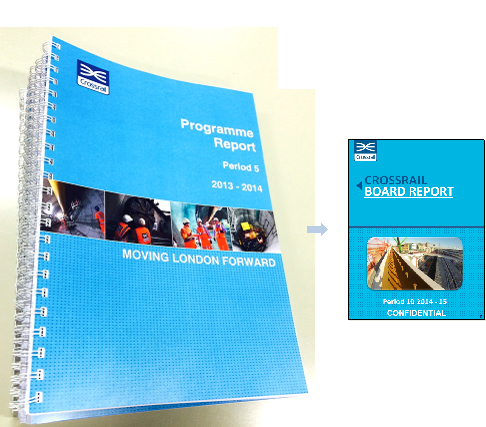
Board Reporting
Document
type: Case Study
Author:
Mark Warren MEng FCMA, Mike Laws ACMA CGMA MBA
Publication
Date: 24/10/2016
-
Abstract
Effective reporting is a result of many separate elements of the Crossrail machine working in harmony to transfer understanding rather than transmit information. To do this in a timely and effective way requires supporting systems and structures and for the value of the outputs to be recognised across the Programme.
The board report combines information from the four measures of performance, On Time, On Schedule, Safe and World Class, and provides them in a narrative and engaging style to provide a balanced view of programme performance which serves as both part of the programme record, and to support management decision making.
-
Read the full document
Introduction
As a high profile programme of exceptional complexity and a large number of internal and external stakeholders, Crossrail has a diverse user group for its management information. Crossrail generates reports tailored to the needs of its users, at each level of the hierarchy. The Board report has been designed to span the gap between internal and external users of management information whilst supporting management enquiry. It also forms part of the programme record.
Crossrail measures performance across four perspectives, and produces management information at all levels, from Contract, Project, Programme and externally to sponsors (DFT and TfL) as well as to the general public. As a publicly funded concern, Value for Money, transparency and clarity of message are of paramount importance to Crossrail.
Background
Effective Board reporting is important but challenging to deliver effectively. This case study seeks to demonstrate that a step change in reporting is achievable without significant investment, with the most important condition for success being a recognition of the need for change in reporting by the senior management team.
The content and context of reporting is, to a greater extent, defined by the audience and the nature of the project or programme. A simple, low value, project with a small number of stakeholders, with little risk and simple drivers and with few opportunities to influence the outcome once initiated, will have very different reporting requirements to a programme at the other extreme, such as Crossrail. This scaling of levels does not infer that reporting is less important in smaller endeavours, only that due to their nature, the complexities are less, and therefore the messages and priorities easier to establish.
The Crossrail team, on a periodic basis, generates a high quality, accessible, content rich Board Report that supports effective governance and decision making. Crossrail has worked hard to build a broad and effective reporting regime – built on a foundation of robust systems and high quality data – of which the Board Report is just one example.
Whilst the report is received by a wide range of stakeholders, the target audience for the Board report is the Non-Executive Directors, as the executive Directors are sufficiently close to the issues, and have prepared for them other reports of greater detail (but narrower scope). Material in the Board report is generated in line with the needs of its users – strategic, balanced and consistent, providing summary information on the issues and risks which are occupying the executive, and their plans for addressing those risks and issues to ensure Crossrail delivers safely, on time, and within its funding envelopeObjectives of Crossrail’s Reporting Function
Crossrail recognises the importance of effective reporting, and as such invests in staff, skills and systems to support it. Reporting is a function within the central Programme Controls team. Its function is to support the programme executive in the effective management of the programme by maintaining the quality and relevance of reporting outputs, enforcing reporting discipline and improving understanding of programme performance. Reporting is done by the business, but is enabled and supported by the Reporting team. Fit for purpose reporting supports the conversation between the projects and the programme executive by meeting the information requirements of the users, using timely data, at the appropriate level of detail, using understandable language which communicates meaning rather than just information.
Figure 1 – Fit for Purpose Reporting
Root Cause Issues
It may seem incongruous that in the 21st century and amid a revolution in corporate systems and ‘Big Data’ that effective reporting remains a challenge. Though the generation, collection and transmission of data has been automated via computerisation, this has a limited effect on the transfer of meaning. Reporting is supported by quality IT rather than led by it.
Generation of the Conditions of Success
There are many requirements for successful reporting. The report itself is an output of a process involving contractors, project and programme staff, IT systems and a wide range of knowledge types. Focusing on the outputs alone, although understandable, misses a very wide range of other factors. Effective reporting is a consequence of far broader organisational issues such as great staff, a clear strategy, high quality data, an effective operating model and management processes. A later section discusses the right foundations for success in more detail.
Understanding the Requirement
With so much data being generated, a critical question is “what do we want to know?” When deciding the report specification, i.e. the report scope, content, tone, structure, frequency, audience and distribution, there are a vast array of options. This uncertainty and complexity can be off-putting and lead organisations down the path of least resistance, showing just key cost and schedule data, or the ‘kitchen sink’ approach of simply aggregating everything created within the organisation. Furthermore, many of the options are conflicting. Therefore, any report must strike the appropriate balance between one or more of the following concerns:
- Report the past vs a forecast of the future
- High level, big picture vs detail and nuance
- What is new vs history and reference material
- Financial vs non-financial data
- Quantified vs commentary
- Leading vs lagging indicators
- Symptom vs root cause
- Fact vs opinion
- Recognise uncertainty vs. confident certainty (until proven wrong)
The purpose of the Board Report is to facilitate and support the executive in making effective, evidence based decisions at the right time. Effective decision making is in itself a critical discipline, balancing speed, accuracy and efficiency. The report also exists to provide a record of programme performance and to convey to Sponsors a measure of confidence in where the delivery of the works is in relation to the works being done safely, on time, within funding and to a world class standard.
Structure the Report to Allow the Sections to be Mutually Supporting
The Board Report has been designed to tell an integrated story which is structured around the four performance pillars of Safety, Within Funding, On schedule and World Class, which Crossrail takes as being analogous to quality. The report is stratified to provide breadth in the first and last sections, and depth in the central “Performance Measure” sections.
Figure 2 – Report Structure
Guiding Principles
Table 1 – Reporting Guiding Principles
Single Page Summarises Performance
Figure 3 – Single Page Summaries
The Section content provides detail, analysis and colour. The report is stratified to provide breadth in the first and last sections, and depth in the central “Performance Measure” sections.
Figure 4 – Report Section Detail
Communication of Meaning Rather Than Transmission of Information
The content of the Crossrail board report is complex because it is a representation of a complex system. The objective is to strike the correct balance between Simple, General and Accurate. Often, reports are produced without the appropriate context, and issued to an audience ill equipped to read and interpret the data and graphs and exercise critical judgement. We seek to support those less familiar with the context such as those new to the project or working as Non-Executive Directors, or simply reading content outside of their areas of expertise, by providing explanation to overcome a major barrier to access, understanding and insight.
A good example of this is the earned value metrics Cost Performance Index (CPI) and Schedule Performance Index (SPI). Within certain constraints and caveats these are powerful descriptive and predictive metrics, but without explanation they present the opportunity to be misunderstood, ignored or alternatively obsessed over to the exclusion of other factors.
The diverse nature of the programme means that functional specialists provide content for their areas of specialisation. The levels of assumed knowledge in the board report are set with the reader rather than the author in mind.
Coherence with the Report Targeting Matrix
The Board report is part of a suite of reporting products which are interrelated and interdependent. The Board report is complementary to other reporting products, primarily strategic and externally focused. The board report can be positioned in the Report Targeting Matrix.
Figure 5 – Report Targeting Matrix
The key principles underpinning the report included:
- Reporting as a vital part of programme control and governance rather than a chore
- Sought to meet the requirements of the audience. – we understood our stakeholders and met their critical information requirement
- We designed a simple structure providing congruence between the performance management framework and the board report
- By putting the key insights up front we ensure that they are immediately apparent and directly answer the obvious questions
- We provide single page summaries of the key topics
- Provide balance between being simple, general and accurate.
- provide graphical, integrated information
- We ensured a professional product is delivered every period, on time, every time.
The end result has improved collective understanding and decision making and ultimately helped maintain confidence and control, reduce risk and drive performance.
Genesis
The report has evolved, along with the programme. It began as a data rich, opinion light volume of over 100 pages, and has moved to a smaller, more visual and more mature report which is now recognised as being fit for purpose, easy to generate and easy to read. The content changes and evolves with the programme, with the content mirroring the focus of the management of the programme, from civils to stations and on to track and railway systems. The report as it stands now is the result of many hours thinking and working of many people making up a diverse team of subject matter experts.
Generation
The report is built in Powerpoint, in portrait orientation and sized to a 9.7 inch iPad screen (all the senior leadership team have been issued iPads). The report is then circulated in pdf form for printing or direct viewing in iBooks. This approach has a number of important advantages:
- It naturally enforces the one page per topic structure, improving focus, prioritisation, and flow,
- The most important messages are always at the top of the page – aiding understanding and focus and encouraging brevity
- It makes it very easy to add, reorder or delete pages in the report
- It aids the creation process. Authors can finalise content and layout offline, submit and be confident the end result will be as they expect
- It allows much easier and professional looking integration of text, graphs, photographs and tables, and better formatting of each page, without the need for expensive and restrictive desktop publishing software
- It allows easy reuse of material from presentations, saving time and building continuity
- It is perfectly readable on an iPad (best using pdf version iBooks). In fact, the iPad format allows rapid movement through the document, search functionality, document links and most usefully the ability to use micro-graphs that can be zoomed in to view, allowing a greater density of information on any one page. Indeed, this format has begun to supersede the printed form amongst the programme leadership
- The format prints easily in A5 booklet form making it much easier to carry around if necessary
The Transformation
The transformation of the board report began as with many other successful transformation projects, with justification of the need for change. This was challenging as the existing report was not bad, in fact for many it was itself world-class. The breakthrough was to agree to produce a prototype.
- The key issues in the existing report to address were:
- Long and detailed sections made it difficult to extract key messages, changes, issues and actions.
- Some key topics were missing
- Structured by Directorate/topic rather than outcome, disrupting flow and not explicitly linking to corporate KPI framework
- Little focus on individual contracts
- Focus on latest period (or two). Difficult to see longer term trends
- Difficult to navigate and read on iPad
- Too much presumed knowledge
- Some data an average of average. Difficult to see outliers
- Reporting takes up majority of Period – no time to stop, listen, think, act
Prototype
The initial prototype was produced in short order; building the PowerPoint template, creating the page headings and then pasting in content from the latest Board Report or creating place holders. This was then revised by the Finance Director, creating a new set of graphs and tables to produce a version suitable for review with the CEO and Programme Director.
Refine
Once a relatively robust prototype was available, this was reviewed by a number of key stakeholders within Finance and Programme Controls as well as the Programme Director and subsequently the CEO. Once the suggestions had been added and issues addressed the prototype was ready for adoption by the Executive Committee. This led to an informal review by the Chairman and a non-executive director. At this point it was agreed to create a shadow version for review at the next Board meeting.
Go Live
Over the course of two weeks a fully complete and up-to-date version was created in parallel to the normal, existing report. This required support from members of the programme controls and finance team and was perhaps the tightest ‘pinch point’ in the implementation. The new report was presented to the Board with an explanation of the changes and their rationale. The Board had very positive feedback on the report content, format and feel and agreed to switch to the new format, with certain amendments, with immediate effect.
Handover and Ongoing Iteration
The work to date had been managed and completed ‘offline’ by the Head of Performance and therefore outside of the usual reporting team, albeit done so in close collaboration. The final stage therefore was to handover the creation process to the usual authors in each Directorate and the central Reporting Team. This was completed through workshops with the whole reporting community and one-to-one support with each author. The next period’s report was completed jointly and the following one simply reviewed to check for issues. At this point the handover was complete. The handover went very smoothly and considerable time savings were evident due to the reduced content and easier aggregation and document management.
In the subsequent periods since go-live the report has constantly evolved, partly in response to moving through the delivery lifecycle (notably the end of tunnelling and start of systems implementation) and partly as the maturity and familiarity with the content increased allowing some of the descriptive and explanatory text and diagrams to be removed and more nuanced information to be added.
In summary, the end result was significantly different from the existing report in size, scope, style and format.
Figure 6 – Final Board Report
Lessons Learned
- For successful delivery of a step change in reporting, a credible need for change needs to be established. This could be a dissatisfaction with the status-quo, or a credible and creative vision, supported by a powerful design, and robust delivery.
- Proceed until apprehended. It is far easier to engage on a topic and make progress with a prototype than conceptually discuss the specification for a hypothetical new report.
- Speed and agility. Rapid progress with dedicated resource and an agile approach to development minimises the operational and reputational risks of change.
- Reporting should be designed to meet the needs of the programme, rather than any one user. No two people have the same view and it was evident early on that to try and satisfy all would lead to a bland and unsatisfactory outcome. Better to have a clear vision and make every effort to deliver against this. This required patient management of certain stakeholders and robustness to politely ignore some feedback.
- Transforming the board report was a corporate achievement, but designed and built by one person. Proof that making such a change is NOT labour intensive.
- MS Office does the job of putting the report together, although there is of course a reliance on a credible individual system recording; cost, schedule, safety performance and other factors.
- Reporting must be flexible and evolve, particularly in a project environment. It can incorporate significant features each Period, and adapt over the delivery lifecycle.
- There is much more which is possible. It is clear that the advances in data systems, data visualisation and other techniques will enable further improvement in corporate reporting, but it is the people within the system which will ultimately be the deciding factor in delivering effective reporting.
-
Authors
Mark Warren MEng FCMA
Mark is an experienced Finance Director and management consultant, working within major projects and company transformation programmes. As Head of Performance for Crossrail Mark provided direct support to the Finance Director to maintain and direct focus on performance, including the design and implementation of the revised Board Report, contract dashboards, and Technical Performance Report.
Mike Laws ACMA CGMA MBA - CH2M, Crossrail Ltd
Mike is Head of Reporting at Crossrail. A programme manager with 10 years experience in delivering large, complex change programmes, principally for public sector clients. Mike has been supporting the Crossrail Programme controls function since March 2015.
-
Peer Reviewers
Kenna Kintrea BSc, MBA, FAPM, Assurance Director, Nuclear Decommissioning Authority










